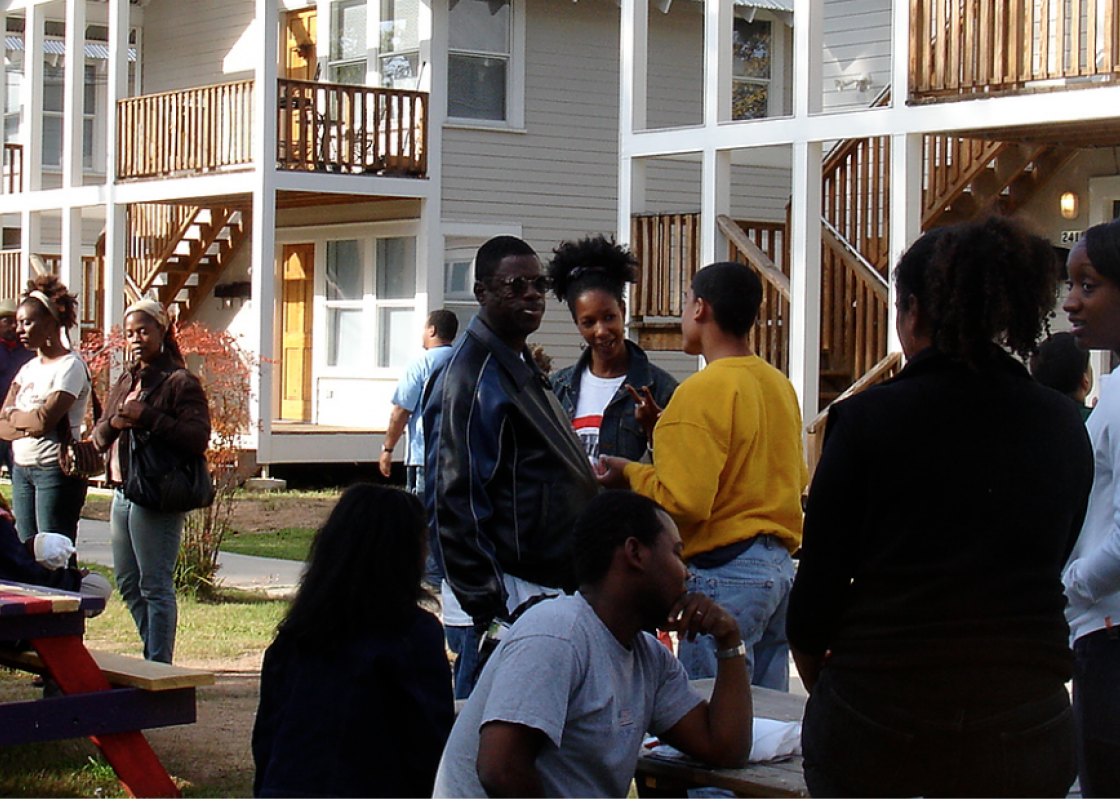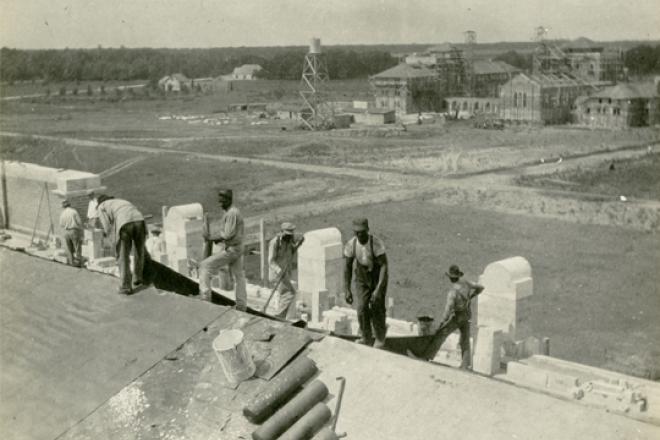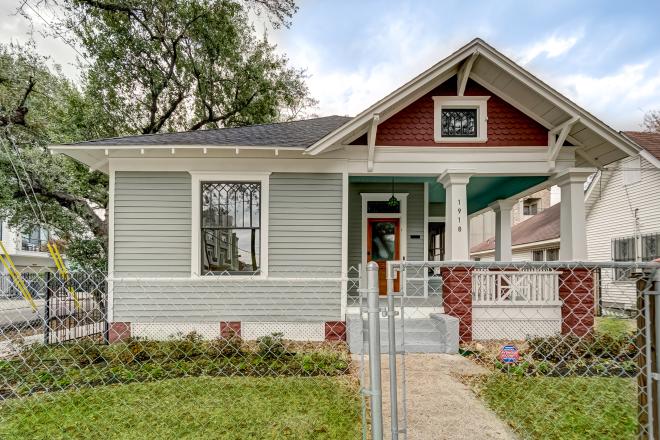This weekend, Emancipation Avenue between McGowen and Blodgett streets will be closed to cars from noon to 4 p.m. for Cigna Sunday Streets HTX and opened to people moving by foot, wheelchair, bicycle, skates, unicycle, and so on. The street itself, originally called Broadway then renamed after Confederate Lt. Richard Dowling in 1892 and renamed Emancipation last year, is itself an important part of the cultural life of Third Ward, Houston, and the U.S. Below are seven points of interest chosen to highlight how Third Ward communities are carrying forward a spirit of emancipation. The sites start just off the Sunday Streets route, then follow it north, and finally loop back down along neighborhood streets taking you close to your starting point. (For more focus on civil rights history, see my guide and write-up for the 2014 Sunday Streets in Third Ward.)
1. Project Row Houses 2501, Holman Avenue
In 1993, when seven visionary African American artists — James Bettison (1958-1997), Bert Long, Jr. (1940-2013), Jesse Lott, Rick Lowe, Floyd Newsum, Bert Samples, and George Smith — recognized real potential in a block and a half of derelict shotgun houses at the corner of Holman and Live Oak in this historic African American neighborhood, they didn’t know how much their efforts would have ripple effects around the country and globe, inspiring generations of artists and arts orgfanization to work within urban communities. Two blocks of 22 cottages, built in the 1930s as rental housing for African American families, were renovated by volunteers with support from a number of local and national funders.
Project Row Houses turned the houses into spaces for art installations that are open to the public at no charge and used others as homes for young mothers. They incubated small businesses and other nonprofits, including a community development corporation. The repetition of the gabled house fronts echoes a series of paintings by John Biggers. In addition to this iconic image, notice the joining of interior and exterior, and the creation of shared spaces through front and back porches and joint backyard spaces. This spatial quality that encourages community is, perhaps, more important to preserving the character of the built environment in Third Ward than the specific form of row houses.
In recent years, land prices have shot up. The neighborhood’s proximity to Downtown attracts developers who build three-story, luxury townhouses. Long-term residents and institutions are seeking to manage these changes on their terms. Project Row Houses helped spur the Emancipation Economic Development Council, a coalition countering displacement through a robust community-led effort focused on affordable housing, economic development, cultural preservation, health, and social mobility that has been supported by funders such as the Surdna Foundation, Houston Endowment, and the Kinder Foundation.
Dr. Assata Richards, a longtime resident of Third Ward, says, “The Emancipation Economic Development Council (EEDC) is not just trying to make suggestions regarding the gentrification set to overwhelm the Northern Third Ward, we are remaking the process of gentrification itself.”
 Francis Street. Photo: Row House CDC.
Francis Street. Photo: Row House CDC.2. Francis Street Development
Project Row Houses and Rice Building Workshop collaborated to create a series of row house-inspired duplexes to provide affordable housing for people in the community. In 2003, Row House CDC was created to act as a sister organization of Project Row Houses to manage the affordable housing program. The two-story duplexes on Francis Street are iterations of a design developed by Rice Architecture students under the direction of Danny Samuels and Nonya Grenader, and take inspiration from the row house with generous porches and shared backyards.
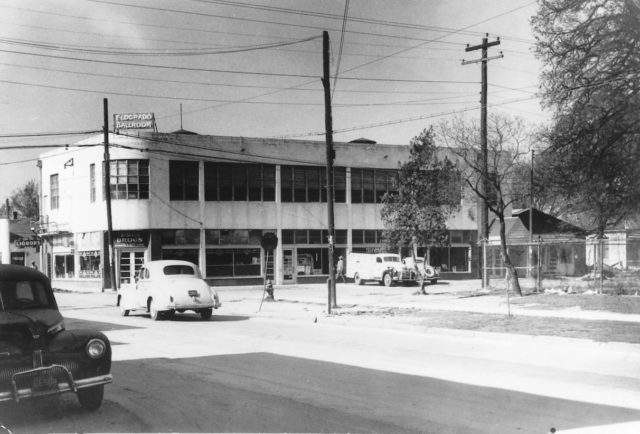 Eldorado Ballroom. Source: Houston Metropolitan Resource Center.
Eldorado Ballroom. Source: Houston Metropolitan Resource Center.3. Eldorado Ballroom 3206 Emancipation Avenue
From 1939 to 1970, many music legends including Ray Charles, Bill Doggett, Guitar Slim, Etta James, Jimmy Reed, Big Joe Turner, and T-Bone Walker played in this streamlined, modernistic nightclub designed by Lenard Gabert. In 1999, the building was acquired by Project Row Houses and has been renovated over time. The first floor has served as an incubator for several nonprofits and business entrepreneurs. Be sure to visit NuWaters Co-op and buy some fresh fruit, tea, or books. Next door, indulge in a neon-pink Cookie Minaj from Crumbville, Texas.
4. Emancipation Park 3018 Emancipation Avenue
The African American community purchased these 10 acres in 1872 as a place to celebrate Juneteenth, the anniversary of the enactment of the Emancipation Proclamation in Texas. In 1916, it was donated to the City of Houston and became the first public park open to African Americans.
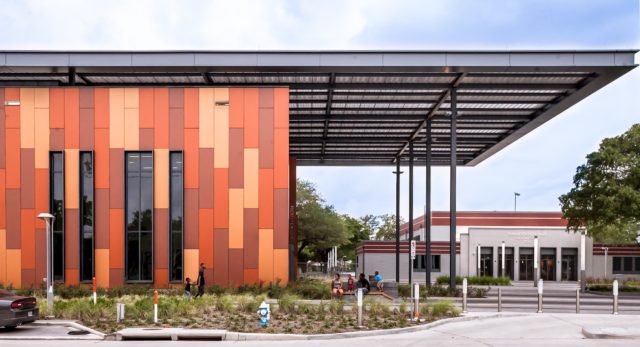 Emancipation Park. Photo: Lee Bey Architectural Photography.
Emancipation Park. Photo: Lee Bey Architectural Photography.A 1939 plan by Hare & Hare organized a swimming pool, community center, and other amenities around a central spine. A major remaking of the park, designed by nationally-known architect Philip Freelon of Perkins+Will, was completed in 2017 after decades of community organizing with a mix of foundation, state, and local funds. A park conservancy, supported with substantial gifts from Houston Endowment and the Kinder Foundation, is bringing a heightened level of programming to re-engage the community.
5. Trinity East United Methodist Church, 2418 McGowen Street/pr>
This church established its Third Ward roots in 1909 and is playing a leading role in developing affordable housing options.
6. Blue Triangle Community Center, 3005 McGowen Street
This 1951 Y.W.C.A. building designed by Hiram A. Salisbury and Birdsall Briscoe offered access to an indoor swimming pool for the African American community. A roof leak has seriously jeopardized the John Biggers’ 1953 mural “The Negro Woman in American Life and Education.” Post-Harvey funding from the NEH, NEA, the Texas Historical Commission, and local foundations may pay for restoration of the painting and capacity-building for the Center.
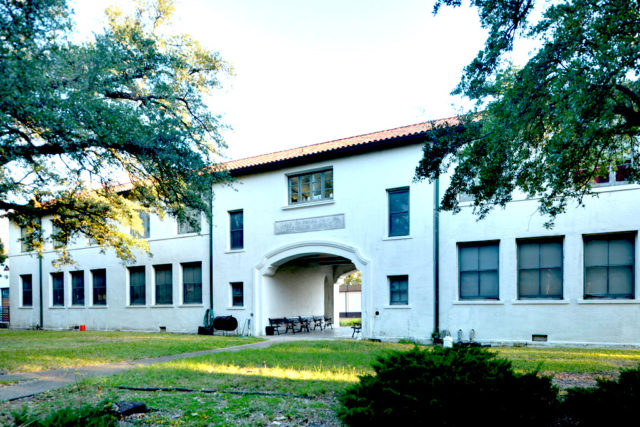 Riverside Hospital, Houston Negro Hospital School of Nursing building. Photo: Ed Uthman, Wikimedia Commons.
Riverside Hospital, Houston Negro Hospital School of Nursing building. Photo: Ed Uthman, Wikimedia Commons.7. Riverside General Hospital, formerly Houston Negro Hospital, 3204 Ennis Street
This community anchor, with buildings dating to 1926 (Hedrick & Gottlieb) and 1931 (Maurice J. Sullivan), has been vacant since 2014. The hospital provided access to healthcare and a nursing school to the Black community. Its revival was identified as a priority by local elected officials, Third Ward residents, and Houston’s healthcare community. With a grant from Houston Endowment, Harris County is working with community leaders to reopen the site as a space for integrated health services for the Third Ward community.
An earlier version of this tour was created in a collaboration of the Funders’ Network for Smart Growth and Livable Communities (TFN) and the Rice Design Alliance at Rice University for The Funders' Network 2018 Annual Conference in Houston. Cite played a role in the beginnings of Sunday Streets and continued as its unabashed cheerleader in over two dozen articles.


